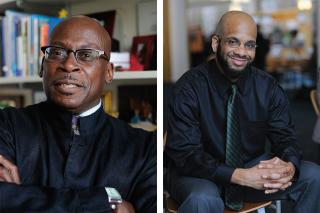On June 16, Gary Bailey, Professor of Practice and Assistant Dean for Community Engagement and Social Justice at Simmons University, moderated a Colleges of the Fenway panel discussion, “Juneteenth, Then and Now: A Conversation on Being the Change Through Arts and Activism."
The panelists included Byron Rushing, who served in the Massachusetts House of Representatives from 1983 to 2018; Makeeba McCreary, Patti and Jonathan Kraft Chief of Learning and Community Engagement at the Museum of Fine Arts, Boston (MFA); and Dr. Daren Graves, Associate Professor of Education and Social Work at Simmons University and Adjunct Lecturer of Education at Harvard Graduate School of Education.
What Juneteenth Means
In light of the recent recognition of Juneteenth as a federal holiday, the panelists reflected on what the day means to them. Rushing questioned whether Juneteenth is a commemoration, or a celebration. “You have to know your history to know what to do in the future, but we don’t talk about the future. We have to connect with the artists and writers who are doing this,” Rushing said. “Rename February Black Future Month. We know the history, now what do we do with it?”
Graves cited the continuing struggles that people of color face today, as well as challenging the notion of Black people being liberated by others as opposed to by themselves. “It speaks to our understanding of our history, of our agency in our freedom. Many Black folks fought in the civil war and by doing so, actively freed themselves. People are, essentially, still in that struggle.”
“Rename February Black Future Month. We know the history, now what do we do with it?”
- Byron Rushing
Representation Matters
McCreary sees this play out at the MFA, where she has made strides to connect the “staid” institution with the community. MFA artists-in-residence, muralist Rob “Problak” Gibbs and illustrator Rob Stull have created murals reflecting the Black experience and commemorating the work of local artists of color. “When I stand at the [Madison Park] mural, I hear little girls say, ‘she’s beautiful, that’s me.’ They see themselves represented in beauty. Their story is being told.”
The mural project was inspired by another MFA exhibit, “Writing the Future: Basquiat and the Hip-Hop Generation,” and she remarked on the courage of integrating this material into what has historically been an institution focused — if inadvertently — on the white experience. “It’s not enough, but it’s those moments of courage that happen one after another and bombard the atmosphere until it isn’t seen as courageous but it’s seen as a necessary way of working and being.”
Making an Impact
Graves, in working with students and his own children, wants to help young people understand the world in front of them. “My goal is to give them the skills to think about what is going on and to have the ability to do something about it.” McCreary agrees, saying that today’s young people “deserve every possible benefit from being a full citizen — it will only make this world a better place.”
But the road won’t be easy. “This is going to be a racist society until it’s not,” said Rushing. “I think black people need to say a prayer in the morning: I am waking up in a racist society. I’m going to overcome it just like my ancestors did.”

